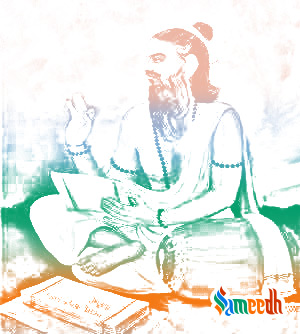Panini is the scholar who transformed the Sanskrit language with scientifically developed grammar. Even today, his principles are used to create computer programming languages.

Image source: Alchetron
The early life of Panini
It is unfortunate that not much is known about the early life of such a scholar and historically significant person. As per the historical inscriptions of King Shiladitya VII, Panini is believed to be born in a place called Shalatula or Salatura which is believed to be around today’s Khyber Pakhtunkhwa area of Pakistan. This is why he has been mentioned as Salaturiya. Another scholar who carried forward his work – Pantanjali mentioned Panini as Dakṣiputra Paṇini – which meant his mother’s name was Dakshi and his father came from the Panina lineage. He is believed to have dwelled on the earth during the 4th to 7th century BCE.
The evolution of Sanskrit
The knowledge of ved-puran was transmitted from generation to generation through oral teachings, and the process of recording them in scriptures began very late. However, the people still used the Sanskrit language to create poetry, literature, scientific studies, and other scriptures – thanks to the evolution of the Sanskrit language. Panini was the scholar who created the Sanskrit grammar and gave us the Classical Sanskrit. It is significantly different from Vedic Sanskrit. He himself didn’t use this terminology, but the modern linguists consider him to be the ‘father of linguistics’ – the ultimate scholar who codified a language based on scientific principles. Numerous modern scholars today study him and his scientific way of developing a language – to improvise and codify the grammar of their language.
The creation of Ashtadhyayi
Ashtadhyayi is the most revered scripture about the Sanskrit language, which is considered to be the impetus behind the rise of Sanskrit as the common people’s language. It is called Ashtadhyayi because there are 8 (Asht) Chapters (Adhyay) in it. This extensive treatise consists of more than 4000 Shlok (Verses). This treatise contains definitions of more than 1700 components of the Sanskrit language. It also contains numerous metarules, compound nouns, ways of constructing sentences, syntax, recursions, and overall grammar rules. It is believed to be the first formal language system in the world. However, Panini himself cites work from more than 10 Grammarians before him – including Rishi Kashyap and Rishi Bharadwaj.
Another scholar Bhatti created Bhattikavya – a maha kavya (epic) narrating the story of Ramayan – as an example to understand the rules specified in Ashtadhyayi.
The Global Awareness About Sanskrit
It is to be noted that most of the current Indian languages have come from a common source – Sanskrit. And regardless of the script used for those languages, their grammar rules seem almost similar. Panini himself was quite popular back then, and the travellers from China and Ancient Greece also mention his name as one of the greatest scholars. Renowned 7th-century Buddhist traveller Hiuen Tsang also mentions him in his memoirs. Panini himself mentions the Yavan (Ionion) people and their kingdom.
The connection with Computer Languages
Today, computer codes are written in numerous different programming languages, and they all need to have a kind of scientific system or Grammar to use them effectively. Paṇini grammar is probably the earliest known computing language. The use of metalanguage and auxiliary markers to create grammatical derivations by Panini is similar to many of the computing languages.